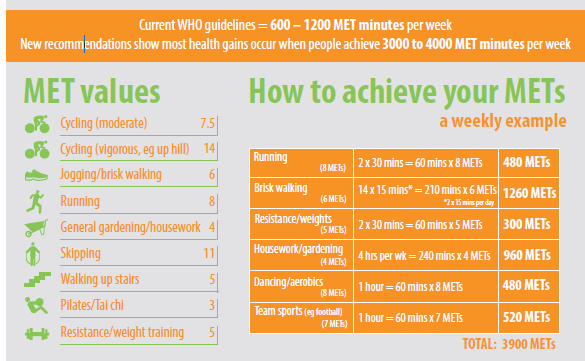
Kimberly Benson PT, DPT, NCS
Prescribing exercise to meet the recommended intensity, frequency and duration are important to consider when educating our patients. Educating patients on exercise and its benefits is an important role of the rehabilitation team. Monitoring progression using the BORG Rating Scale of Perceived Exertion (RPE) is one simple way to ensure the intensity is met. RPE has been validated as a reliable measure for assessing intensity1 and the results of the studies suggest that combining aerobic, muscle strengthening, bone strength, flexibility, and balance is needed to maximize the health benefits.2
In 2018, the U.S. Department of Health and Human Services published the 2nd edition of Physical Activity Guidelines.2 These guidelines state the following recommendations for adults, regardless of gender: to participate in at least 150 minutes (2 hours and 30 minutes) to 300 minutes (5 hours) a week of moderate-intensity, or 75 minutes (1 hour and 15 minutes) to 150 minutes (2 hours and 30 minutes) a week of vigorous-intensity aerobic physical activity, or an equivalent combination of moderate- and vigorous-intensity aerobic activity. These aerobic activities should be performed throughout the week.
For adults with disabilities and chronic conditions, it is recommended that the activities are designed based on what their abilities allow and they continue to strive for the 150 minutes of activity.3 This is a change from the 2008 Physical Activity Guidelines for Americans. Previously, aerobic physical activity for adults had to be accumulated in bouts, or sessions, that lasted at least 10 minutes to count toward meeting the key guidelines. Current evidence suggests that the total volume of moderate-to-vigorous physical activity is related to many health benefits; bouts of a prescribed duration are not essential. Other key points can be found in the Physical Activity Guidelines for Americans.3
There are a few ways to monitor intensity. The guidelines propose using the Metabolic Equivalent of Task (MET), which are the absolute rates of energy expenditure during physical activity. 1 MET is equivalent to the resting metabolic rate or the energy expenditure while awake and sitting quietly. Moderate-intensity activities have a MET value of 3 to 5.9 METs; vigorous-intensity activities have a MET value of 6 or greater Moderate-intensity activity requires 3.0 to less than 6.0 METs. Table 1 provides examples of MET values for moderate-intensity and vigorous-intensity activities. Keep in mind, many adults do not participate in vigorous-intensity physical activity and therefore it’s important to educate them on what vigorous-intensity is.
Table 1: Examples of MET Values

Accessed at WCPT 4
Reference